U.S. Department of Transportation
Federal Highway Administration
1200 New Jersey Avenue, SE
Washington, DC 20590
202-366-4000
Federal Highway Administration Research and Technology
Coordinating, Developing, and Delivering Highway Transportation Innovations
|
Research & Technology Transporter This newsletter is an archived publication and may contain dated technical, contact, and link information. |
|
| Publication Number: N/A Date: February 1999 |
Publication Date: February 1999
|
The American Society of Testing Materials (ASTM) honored Dr. Stephen Forster with the 1998 Prevost Hubbard Award. This award is presented annually by ASTM Committee D-4 on Road and Testing Materials to individuals who have provided outstanding service to the committee and have worked in the field of bituminous road and paving materials. Dr. Forster received this award for his distinguished leadership and standards-writing contributions to the committee.
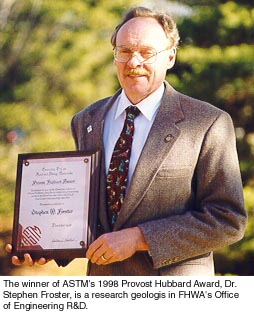
A research geologist in FHWA's Office of Engineering Research and Development, Dr. Forster is an expert on performance, distress, and durability of portland cement concrete and aggregate. Under his leadership, Subcommittee D-4.51 on Aggregate Tests developed a number of tests to better characterize aggregate for use in bituminous mixtures. He helped write the standard test method for flat and elongated particles in coarse aggregate and the standard test method for determining the percentage of fractured particles in coarse aggregate. Currently, the committee has more than a dozen test methods for aggregate under its jurisdiction. Dr. Forster has been a member of D-4.51 since 1978.
Dr. Forster has been employed by FHWA since 1975. He is active in the Transportation Research Board and was recently elected as Fellow of the American Concrete Institute, where he chairs Committee 221 on Aggregates.
Haruyo Nakashima haruyo.nakashima@fhwa.dot.gov
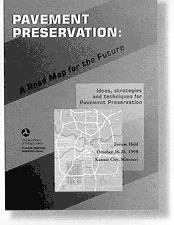
One of the key challenges facing highway agencies today is maintaining the quality of existing pavements. A new FHWA publication due out in February, Pavement Preservation: A Road Map for the Future, addresses this challenge by identifying important steps for highway agencies, industry, and others to consider when planning pavement preservation strategies.
The publication is the result of "Forum for the Future," a gathering that took place last October in Kansas City, MO, and involved more than 100 preventive maintenance experts from highway agencies, industry, academia, and FHWA. The forum was the first opportunity for stakeholders to meet and to devise priorities and strategies for enhancing system preservation.
The participants focused on six areas:
For each area, they developed specific recommendations for research, testing, training, and policy improvements.
Participants in the forum emphasized the need to shift from believing in the traditional philosophy of continually expanding and upgrading our highway system, to believing in a philosophy of maintaining and preserving it. The forum provided an opportunity to determine what new tools State and local highway agencies will need to make the shift to pavement preservation, as well as the best ways to get those tools to users.
To request a copy of Pavement Preservation: A Road Map for the Future (Publication No. FHWA-SA-99-015), contact FHWA's Research and Technology Report Center by phone, (301) 577-0906; or by fax, (301) 577-1421.
Jim Sorenson (202) 366-1333 james.sorenson@fhwa.dot.gov
On December 22, 1998, a U.S. patent was granted to Dr. Mohammed Memon for inventing a process that improves the reactivity, separation, and rheological properties of crumb rubber modified asphalt. This process calls for the chemical modification of crumb rubber particles. This process will produce high-performance pavements and bring about considerable cost savings to the pavement industry. It was developed at FHWA's Turner-Fairbank Highway Research Center in McLean, VA.
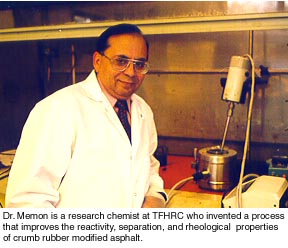
The new crumb rubber modified asphalt can be prepared using readily available materials. In the new process, some crumb rubber particles are treated with a carbonium ion-generating material that enhances the production of carboxylic sites. When the treated particles are added to the asphalt, they react more fully in the asphalt, and more treated particles are suspended than untreated particles. Pavements made with the newly patented process can withstand a wider range of temperatures, have reduced raveling, and have fewer pavement-performance problems.
Dr. Memon is a research chemist working under a contract to the Office of Engineering Research and Development. He received his doctorate from the University of Sindh in Pakistan and has worked for FHWA as a contractor for seven years. His areas of expertise are asphalt, the environment, surfaces, and polymer chemistry.
Haruyo Nakashima haruyo.nakashima@fhwa.dot.gov
The longest three-pin arch bridge over water in the United States has just been completed. The Fontana Park Bridge in Iowa was constructed out of 104,600 board feet of timber and was built using Federal funds to demonstrate that wood is a durable and aesthetically pleasing building material.
The Fontana Park Bridge replaces a high truss iron bridge constructed in 1911. Corrosion and continuous loading took a heavy toll on this iron bridge, making replacement inevitable. Iowa conservation department employees feared that this picturesque iron bridge would have to be replaced with a concrete slab bridge. While the concrete slab bridge would be functional, it would detract from the natural beauty of the park. The Intermodal Surface Transportation Efficiency Act of 1991 (ISTEA) timber bridge research fund provided a fiscal source for the construction of this new aesthetically pleasing three-pin wooden bridge that will demonstrate excellent performance while blending in perfectly with the park environment.
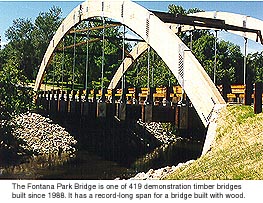
In 1988, interest in using wood for building bridges was renewed by the establishment of the Timber Bridge Initiative. This interest in timber bridges continued when the ISTEA was passed, which contained provisions for timber bridge research, technology transfer, and demonstration projects. The ISTEA program helped pay for the Fontana Park Bridge and has been the responsibility of FHWA.
This three-pin bridge is 8 meters wide, 42 meters long and can simultaneously hold two loaded semi trucks without restriction. The three-pin arch design has a pin at each end of its arches with one pin in the center of each arch. The bridge arches are constructed of southern yellow pine, while the basic design is comprised of Douglas fir.
This project is an ideal research and demonstration bridge because of the length of the span, its corrosion resistance to ice and snow treatments, and its resistance to the variety of loads C including semis and Amish horse-drawn carriages that cross the bridge daily. The materials used to build the bridge blend in well with the wooded park environment.
Wood has been used for building bridges for hundreds of years. Since the turn of the century however, wood has slowly been replaced with other materials, such as steel and concrete, as the preferred bridge building material. As a result, the incentive to conduct research to advance wood technology for vehicular bridges diminished.
All together there are approximately 38,298 timber bridges in the United States and 39,503 steel bridge with timber decks. Since the initiation of these programs in 1988, 419 demonstration timber bridges have been built. Since 1988 approximately 2,762 timber bridges were built.
Sheila Duwadi (202) 493-3038 sheila.duwadi@fhwa.dot.gov
Four hundred participants from around the world gathered in Orlando, FL, in December for the International Conference on Corrosion and Rehabilitation of Reinforced Concrete Structures. Corrosion in steel-reinforced concrete is the leading cause of deterioration in bridges and other structures, exerting a heavy toll on highway agencies, who must bear the costs of rehabilitating, replacing, and maintaining those structures.
The conference focused on strategies for preventing and mitigating corrosion, including using technologies such as cathodic protection and electrochemical chloride extraction. The conference also covered new methods for evaluating the condition of reinforced concrete and the use of alternative reinforcement methods in bridge construction.
Conference sponsors included the National Research Council-Canada, American Association of State Highway and Transportation Officials, American Public Works Association, National Association of Corrosion Engineers, International Concrete Repair Institute, and FHWA.
The conference proceedings are available on CD-ROM. To obtain a copy, contact Doris Hooks at Visions USA by phone, 800-780-8872 (extension 246); by fax, 404-880-0404; or by e-mail: dhooks@visionsusainc.com.
Donald Jackson (202) 366-6770 donald.jackson@fhwa.dot.gov
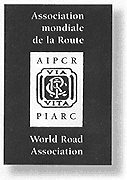
CD-Route, a CD-ROM from the World Road Association (PIARC), is now available on the FHWA intranet. CD-Route is a compilation of 12,000 pages of reports, articles, a dictionary and lexicon, and presentations of PIARC, its committees and working groups. The CD also includes full text documents from the World Bank and the Organization for Economic Cooperation and Development, available in both English and French. This product is a good resource for information on road-related technical and policy topics and developments around the world.
The CD requires Adobe Acrobat to open, and users can view the documents and search by topic or key words. FHWA staff can access the CD at: http://staffnet.fhwa.dot.gov/cdimage/CD-ROUTE.PDF. Readers outside of FHWA can order the CD from the World Road Association (www.piarc.inrets.fr).
Sherif Gamal (202) 366-2155 international@fhwa.dot.gov
FHWA, in cooperation with the World Bank, hosted a conference on Public Policy Issues in Global Freight Logistics in Washington, DC, on December 17 and 18, 1998. The conference was the third in a series sponsored by the Organization for Economic Cooperation and Development (OECD).
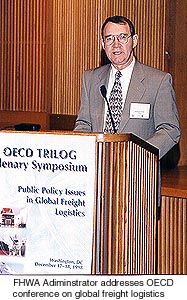
In 1996, OECD established the Trilateral Logistics Project (TRILOG) to identify the main inefficiencies and barriers in logistics processes and to exchange information and experience from around the world. Three regional task forces (North and South America, Asia-Pacific, and Europe) are working independently to identify region-specific issues affecting logistics and freight transportation. These issues will be incorporated into inter-regional policy and management resources, which can facilitate the development of logistics infrastructure and enhance global industry growth. The North American Regional Reference Group is led by FHWA's Office of International Programs.
The conference was attended by 150 experts on the subject from around the world. Participants explored key issues that define freight transport and logistics from the North American perspective and discussed topics such as global and regional logistics, financing networks, human resource implications, and performance measure and data requirements for global logistics. The conference also examined programs, policies, and experiences from Canada, Mexico, and the United States, particularly under the North America Free Trade Agreement.
The proceedings from this conference will be integrated with the other regional findings into an overall OECD institutional policy framework on global logistics during 1999.
Bert Schacknies (202) 366-5044 international@fhwa.dot.gov
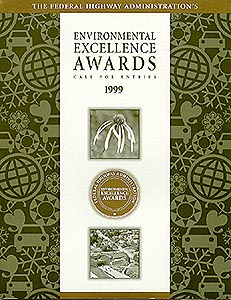
In January, judges convened at FHWA headquarters to select winners for the 1999 Environmental Excellence Awards. This program acknowledges projects, processes, and people who excel in meeting the growing transportation demand, while protecting and enhancing our environment.
Nominations have been received from 35 States, and more than 600 people have been recognized for incorporating environmental stewardship into the planning and project development process using FHWA funding sources.
The 1999 Environmental Excellence Awards has twelve categories:
This program has grown in the number of applications and in the number of categories. The program honors and recognizes not only projects, but also recognizes our partners who institute creative research and leadership in the process of planning and project development.
The winners will be announced at the 1999 Earth Day Celebration in Washington, DC.
Patricia Cazenas (202)-366-4085 patricia.cazenas@fhwa.dot.gov
By using computer graphics, FHWA researchers can form three-dimensional (3-D) and four-dimensional (4-D) visual simulations of highway projects, creating a Virtual highway" on their computer screen. Users get the impression they are walking (or driving) through a particular highway design before the design is even implemented. Highway researchers can now use what they learn from this Virtual highway" to improve the actual highway.
These 3-D computer images are generated from two-dimensional (flat) computer-aided design files. The third dimension adds depth and texture to an image. The fourth dimension is the element of the simulation that allows the user to "walk through"-or in the case of highway projects, to "drive through"-the highway design.
FHWA is preparing a CD-ROM that will present the evaluation results on the effectiveness of the 3-D and 4-D visualization used in a recent Florida highway design project. The CD-ROM, An Evaluation of the Use of 3-D/4-D Visualization of the North/South Roosevelt Blvd. Project in Key West, Florida, contains an overview of the study; the design alternatives presented to the Key West community; discussions of the focus of, the requirements for, and the process involved in 3-D/4-D visualization research; and the project's evaluation results. The CD-ROM includes the following information:
For more information, call the contact below.
Carol Tan Esse (202) 493-3315 carol.tan.esse@fhwa.dot.gov.